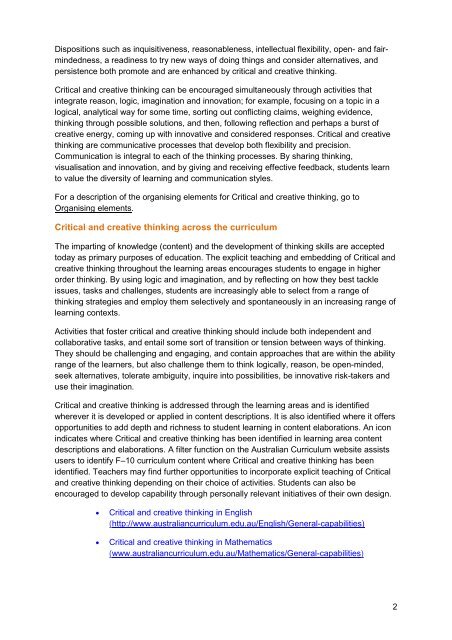Critical-and-creative-thinking
Critical-and-creative-thinking
Critical-and-creative-thinking
You also want an ePaper? Increase the reach of your titles
YUMPU automatically turns print PDFs into web optimized ePapers that Google loves.
Dispositions such as inquisitiveness, reasonableness, intellectual flexibility, open- <strong>and</strong> fairmindedness,<br />
a readiness to try new ways of doing things <strong>and</strong> consider alternatives, <strong>and</strong><br />
persistence both promote <strong>and</strong> are enhanced by critical <strong>and</strong> <strong>creative</strong> <strong>thinking</strong>.<br />
<strong>Critical</strong> <strong>and</strong> <strong>creative</strong> <strong>thinking</strong> can be encouraged simultaneously through activities that<br />
integrate reason, logic, imagination <strong>and</strong> innovation; for example, focusing on a topic in a<br />
logical, analytical way for some time, sorting out conflicting claims, weighing evidence,<br />
<strong>thinking</strong> through possible solutions, <strong>and</strong> then, following reflection <strong>and</strong> perhaps a burst of<br />
<strong>creative</strong> energy, coming up with innovative <strong>and</strong> considered responses. <strong>Critical</strong> <strong>and</strong> <strong>creative</strong><br />
<strong>thinking</strong> are communicative processes that develop both flexibility <strong>and</strong> precision.<br />
Communication is integral to each of the <strong>thinking</strong> processes. By sharing <strong>thinking</strong>,<br />
visualisation <strong>and</strong> innovation, <strong>and</strong> by giving <strong>and</strong> receiving effective feedback, students learn<br />
to value the diversity of learning <strong>and</strong> communication styles.<br />
For a description of the organising elements for <strong>Critical</strong> <strong>and</strong> <strong>creative</strong> <strong>thinking</strong>, go to<br />
Organising elements.<br />
<strong>Critical</strong> <strong>and</strong> <strong>creative</strong> <strong>thinking</strong> across the curriculum<br />
The imparting of knowledge (content) <strong>and</strong> the development of <strong>thinking</strong> skills are accepted<br />
today as primary purposes of education. The explicit teaching <strong>and</strong> embedding of <strong>Critical</strong> <strong>and</strong><br />
<strong>creative</strong> <strong>thinking</strong> throughout the learning areas encourages students to engage in higher<br />
order <strong>thinking</strong>. By using logic <strong>and</strong> imagination, <strong>and</strong> by reflecting on how they best tackle<br />
issues, tasks <strong>and</strong> challenges, students are increasingly able to select from a range of<br />
<strong>thinking</strong> strategies <strong>and</strong> employ them selectively <strong>and</strong> spontaneously in an increasing range of<br />
learning contexts.<br />
Activities that foster critical <strong>and</strong> <strong>creative</strong> <strong>thinking</strong> should include both independent <strong>and</strong><br />
collaborative tasks, <strong>and</strong> entail some sort of transition or tension between ways of <strong>thinking</strong>.<br />
They should be challenging <strong>and</strong> engaging, <strong>and</strong> contain approaches that are within the ability<br />
range of the learners, but also challenge them to think logically, reason, be open-minded,<br />
seek alternatives, tolerate ambiguity, inquire into possibilities, be innovative risk-takers <strong>and</strong><br />
use their imagination.<br />
<strong>Critical</strong> <strong>and</strong> <strong>creative</strong> <strong>thinking</strong> is addressed through the learning areas <strong>and</strong> is identified<br />
wherever it is developed or applied in content descriptions. It is also identified where it offers<br />
opportunities to add depth <strong>and</strong> richness to student learning in content elaborations. An icon<br />
indicates where <strong>Critical</strong> <strong>and</strong> <strong>creative</strong> <strong>thinking</strong> has been identified in learning area content<br />
descriptions <strong>and</strong> elaborations. A filter function on the Australian Curriculum website assists<br />
users to identify F–10 curriculum content where <strong>Critical</strong> <strong>and</strong> <strong>creative</strong> <strong>thinking</strong> has been<br />
identified. Teachers may find further opportunities to incorporate explicit teaching of <strong>Critical</strong><br />
<strong>and</strong> <strong>creative</strong> <strong>thinking</strong> depending on their choice of activities. Students can also be<br />
encouraged to develop capability through personally relevant initiatives of their own design.<br />
• <strong>Critical</strong> <strong>and</strong> <strong>creative</strong> <strong>thinking</strong> in English<br />
(http://www.australiancurriculum.edu.au/English/General-capabilities)<br />
• <strong>Critical</strong> <strong>and</strong> <strong>creative</strong> <strong>thinking</strong> in Mathematics<br />
(www.australiancurriculum.edu.au/Mathematics/General-capabilities)<br />
2


